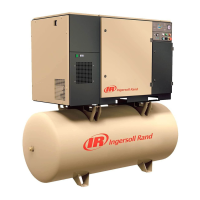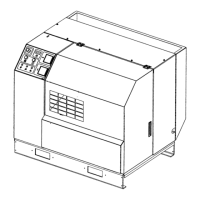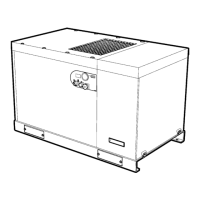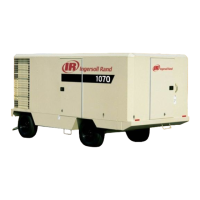10
2.4 PIPING
It is essential when installing a new compressor to
review the total plant air system.This is to insure a safe
and effective total system.
The use of plastic bowls on line filters without metal
guards can be hazardous.Their safety can be affected
by either synthetic lubricants or the additives used in
mineral oils. From a safety standpoint, metal bowls
should be used on any pressurized system.
Condensed water occurs naturally in air lines as a result
of compression. Moisture vapor in ambient air is concen-
trated when pressurized and condenses when cooled in
downstream air piping.
Moisture in compressed air is responsible for costly
problems in almost every application that relies on com-
pressed air. Some common problems caused by mois-
ture are: rusting and scaling in pipelines, clogging of
instruments, sticking of control valves, and freezing of
outdoor compressed air lines. Any of these could result
in partial or total shutdown of the compressed air sys-
tem.
The compressed air discharging from this compressor
will be at some elevated temperature and will therefore
contain amounts of water vapor. As this air cools, the
vapor will condense within the piping system.
IMPORTANT:The drain line must slope downward from
the trap to work properly.
NOTE: For ease of inspection of the automatic drain
trap operation, the drain piping should include an open
funnel or some type of sight flow indicator.
It is possible that additional condensation can occur if
the downstream piping cools the air even further.
Therefore, low points in the piping system should be
provided with driplegs and traps.
Compressed air dryers reduce the water vapor concen-
tration and prevent liquid water formation in compressed
air lines. Dryers are a necessary companion to filters,
aftercoolers, and automatic drains for improving the pro-
ductivity of compressed air systems.Two types of dry-
ers, refrigerated or desiccant , are used to correct mois-
ture related problems in a compressed air system.
Refrigerated dryers are normally specified where com-
pressed air pressure dew points of 33°F to 39°F (.5°C to
4°C) are adequate. Desiccant dryers are required where
pressure dew points must be below 33°F (.5°C).
! WARNING
Do not use plastic pipe, soldered copper fittings
or rubber hose for discharge piping.
Figure 2.4-1 indicates the approximate moisture con-
tent in compressed air at various operating points.
Contact your local Ingersoll-Rand Distributor or Air
Center for assistance in selecting correct Ingersoll-
Rand filtration or drying products.
Moisture Content of Compressed Air
FIGURE 2.4-1 MOISTURE CONTENT OF
COMPRESSED AIR
200
160
120
80
40
0
DEW POINT
❏ without 100°F (with 35°F -40°F (Desiccant
Aftercooling Aftercooler) (Refrigerated Dryer)
Dryer)

